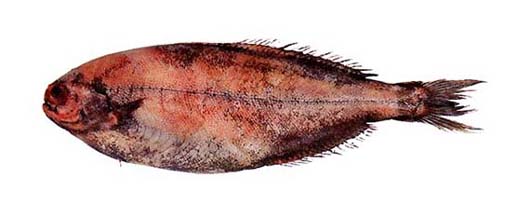イボダイ科
- HOME
- デジタル図鑑
- パタゴニア海域の重要水族
- 硬骨魚綱 スズキ目
- イボダイ科
イボダイ科(Centrolophidae)

116 ボロイボダイ(Boro-ibodai)
Icichthys australis Haedrich, 1966
White warehou (NZ.)
特 徴:
背鰭39〜43鰭条,臀鰭25〜28鰭条,胸鰭16〜17軟条,腹鰭1棘,5軟条,鰓耙数6〜7+11=17〜18。頭長は体長の19.4〜20.9%,眼径は1.9〜2.2%,吻長は4.1〜4.8%,上顎長は4.6〜4.9%,両眼間隔は5.2〜5.8%,体高は35.0〜37.7%,尾柄高は9.2〜10.3%,胸鰭長は10.0〜11.5%,腹鰭長は2.7〜3.2%,背鰭高は5.6〜7.0%,臀鰭高は5.1〜6.3%。体高は高く,体形は著しく側扁し,体長は体高の2.7〜2.9倍。頭は小さく,体長は頭長の4.8〜5.2倍。吻は円鈍で,短くて弱く,トロール漁法で漁獲されるとしばしば吻端は損傷される。口は小さく,両顎は同長。上顎後端は眼の前縁下に達する。両顎歯は絨毛状。鋤骨と口蓋骨は無歯。眼の上から鰓蓋部にかけて6〜7個の管状孔が並ぶ。眼は小さく,頭長は眼径の約10倍。約20個の感覚孔が眼の周囲にある。鰓耙は柔らかくて短く,内側に鋸歯を備える。擬鰓がよく発達する。両眼間隔域は広く,その幅は眼径の約3倍。両眼間隔域から背鰭起部にかけて浅い溝がある。腹部は大きく湾曲し,腹鰭から肛門にかけて肉質隆起がある。胸鰭は丸味を帯びて,短く,その長さは頭長の約半分。腹鰭は非常に小さく,柄状部を備え,胸鰭基底後縁下にその起部が位置する。背鰭と臀鰭は低くて基底が長く,被鱗した肉質鞘を備える。尾鰭は小さく,弱く二叉する。尾柄高は高く,ほぼ胸鰭長に等しい。鱗は小円鱗で脱落しやすい。側線は単線でやや不明確で,背縁近くを背縁の輪郭に平行に走る。
分 布:
チリ パタゴニア,ニュージーランド。
備 考:
Icichthys属魚類はイボダイ類の中でも原始的と考えられているが,脊椎骨だけは基本的なイボダイ類の25に対して,その約2倍の50〜60と進んだ状態にある(Haedrich, 1967)。
(中村 泉)
Material examined:
3 from Chile (420.5-565.0 mm SL), FAKU CP 978-980.
Description:
D 39-43 (total element); A 25-28 (total element); P1 16-17; P2Ⅰ, 5; GR 6-7+11=17-18. HL 19.4-20.9% of SL; ED 1.9-2.2; BD 35.0-37.7; SN 4.1-4.8; IO 5.2-5.8; UJ 4.6-4.9; CP 9.2-10.3; P1L 10.0-11.5; P2L 2.7-3.2; DH 5.6-7.0; AH 5.1-6.3.
Body deep and extremely compressed, body depth 2.7-2.9 times in SL. Head small, its length 4.8-5.2 times in SL. Snout blunt, short, weak, often damaged by trawling catch. Mouth terminal and small, posterior margin of upper jaw reaching anterior margin of eye. Small villiform teeth on both jaws. No teeth on vomer or palatines. Six to seven large lipped pores on each side of head, above eye and gill-cover. Eye small, about 10 times in HL. About 20 small sensory pores around eye. Gill-rakers soft, short with inner serrations. Pseudobranchiae well developed. Interorbital region wide, its width about 3 times of eye diameter. A shallow longitudinal groove from interorbital region toward dorsal fin origin. Belly fairly convex, with a fleshy keel between pelvic fin and anus. Pectoral fin round and short, its length about half of head. Pelvic fin very small with flesy peduncle situated slightly posterior to level of posterior insertion of pectoral fin. Dorsal and anal fins low with scaled fleshy sheath. Dorsal fin base longer than anal fin base. Caudal fin weakly forked with deep caudal peduncle, caudal peduncle depth nearly equal to or slightly shorter than pectoral fin. Small deciduous cycloid scales covering head and body. Lateral line obscure, running parallel to dorsal profile. Body uniformly dark brownish, tip of each fin and gill-membrane tinged with black.
Distribution:
Chilean Patagonia and New Zealand.
Remarks:
Icichthys, a menber of the most primitive group of stromateoids, has a very high number of vertebrae, an advanced condition; the number, between 50 and 60, is slightly more than twice the basic perciform number, 25, found in other centrolophids (Headrich, 1967).
(Izumi NAKAMURA)

Distribution of Icichthys australis in Patagonia.